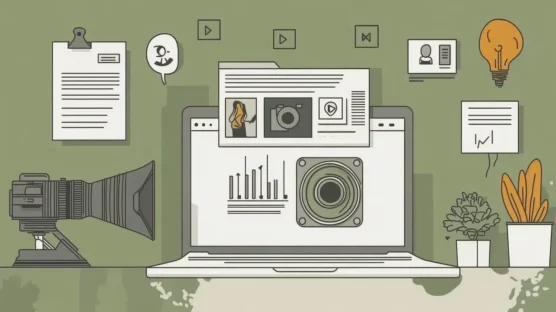In October we took a look at why it pays off to use videos in marketing and communications, and gave tips on how to get started. Now we dig in deeper to the possibilities of video format.
1. Reinforcing online brand
Because we spend more and more time online, the online brand's meaning to a brand is now more imporant than ever – so important that it shouldn't be viewed as a separate thing. This is backed up by Google, since according to them approximately 57 percent of the customer's buying process has happened before making any contact – in both B2B and B2C market.
Everyone hasn't kept up with the changes and many otherwise strong brands have a weak online visibility.
Online brand experience consists of many factors and online presence must be comprehensive and convincing. This means different things in different fields. Is the company represented in the right media, does it pop up in search engines with the right keywords, are its personnel profiled as experts? What does the search result with the company's name look like? How about when looked at with mobile?
Is the company a forerunner or dragging behind in adapting new social media or using online customer service? Does the customer experience online correlate to the customer experience in a store, or does the customer call out to the seller in vain when payment systems don't work? How does the website itself work?
All this together influences the customer's perception of the company. Brand experience affects customer loyalty and quality experience – thus directly the sales figures.
Why and how video?
Video content is a more and more popular way to get information about a company. Because search engines favor videos, and not all companies are doing them, a company that shows up in search results with videos has a strong edge. Video content brings diversity into online content and effectiveness as well as variation into the customer experience of websites.
Because video enables the use of visuality, music and stories creatively, it works especially well in brand communications that aims to create or reinforce a brand instead of direct selling.
Videos are one of the best ways to evoke emotions in the digital world. For this reason, among others, they are shared more easily than other marketing content. This way you get more out of your marketing budget.
2. Press releases and doing PR online
For years now, PR hasn't been merely sending press releases to journalists' emails and building relationships at events: the web has a continuously bigger role. Press releases need to be found also online and they should be shared in social media. The company and, in the best case scenario, its personnel need to be profiled as experts in online channels as well, and also networking happens more and more online.
Why and how video?
Even though it is known that press releases with images, videos or charts work best, the majority of press releases are still sent without them. Those in PR that know how to take advantage of this possibility stand out from the crowd.
One key factor in branding yourself as an expert of your field is professional online presence. Make sure that if your employees are interviewed these videos can be found on YouTube and other video services – and on your company's account as well as press releases.
YouTube is the second most popular search engine in the world, so naturally also journalists use it. Make sure that they find good, current content about relevant issues. Actively offer to be interviewed, for example. When presentable and professional interviews can easily be found online, journalists dare to ask comments in the future as well.
3. Website numbers that matter
The three most important things for a website are the number of visitors, time spend on the site and convertion. Inside these statistics are good usability, appealing and involving content, customer service, as well as technical functionality.
Why and how video?
Bring visitors to the site: Videos are shared more easily than other content and they can help to direct visitors to a website through social media and newsletters. Make sure that both the videos and video services provide easy access and clear encouragement to move on to your website.
Hold on to a visitor: Website visitors want easy, fast and working information or entertainment and video is a handy format for that. More time is spent on sites that have video content than on those that don't have it. Videos are also great tools for guiding: if something is complex in your product or service, make a short guide video to your site.
Convert into a customer: Customers that, before purhasing a product, have seen a video of this product are more likely to buy it. A good video can also replace customer service (user guides and product presentations) or even sales meetings ("why you should become our customer") and convert a website visitor straight into a customer. Remember clear calls-to-action: "book now" or "get a demo now".
4. Reinforcing employer brand
Choosing an employer involves a lot more than assessing a job posting. Does the company seem reliable, does it offer challenges, is it current, what its company culture is like? Potential employees form their overall impression based on the picture that is painted by Twitter account, LinkedIn presence, website employer section and online discussions that pop up in search engines.
Because so much of our time is spent at work, decisions that are related to it are made based on emotion as well as reason. Does the company seem "your own", does the crowd seem like something that you'd want to be a part of. Is the company hierarchical and rigid, or relaxed and agile? Bringing forth these aspects and evoking emotions can be done most successfully with a video or through images.
Why and how video?
Employee introductions: Peer recommendations are always trusted more than a company's own messages. These two can be combined by creating introduction videos where employees working with different tasks tell about their jobs. Two birds with one stone: the credibility of recommendations in a form that the company can control. However, make sure that the interview stays genuine and comes from the heart – faking doesn't go unnoticed.
Documenting the day-to-day: It's hard to fake day-to-day life; nothing tells a better or more genuine story of your corporate culture than a depiction of true everyday life. Choose a channel where the company can present itself more casually and freely and use incentives to get the whole personnel involved in content creation. Whereas a picture is worth a thousand words, a short video is worth even more. For example, see Liana Technologies Instagram account.
Employer brand video: Like for all branding, videos also work well for employer branding. A good video tells everything essential about the company as an employer in two minutes – a lot less can be said in the same time with written word. See an example of an employer video at SAS.
Some picks of the numerous other ways to use videos:
- Decrease the amount of support requests by replacing the FAQ portion with ”what to do in problem situations” videos
- Train new customers to use a product or a service with videos, for example a weekly drip campaign
- Brand yourself as an expert with a training video series
- Create a case video instead of a case presentation to support sales
- Present the annual review
- Handle in-house training
- Create a video presentation instead of a whitepaper
- Present studies and statistics.
Would you like to utilize video in public relations or email marketing? Contact our experts and learn more.



![How to Get Started with Podcasts? [Infographic]](/media/blog/podcast-article/cache/starting-your-own-podcast-article-cover-378x214,c.png)